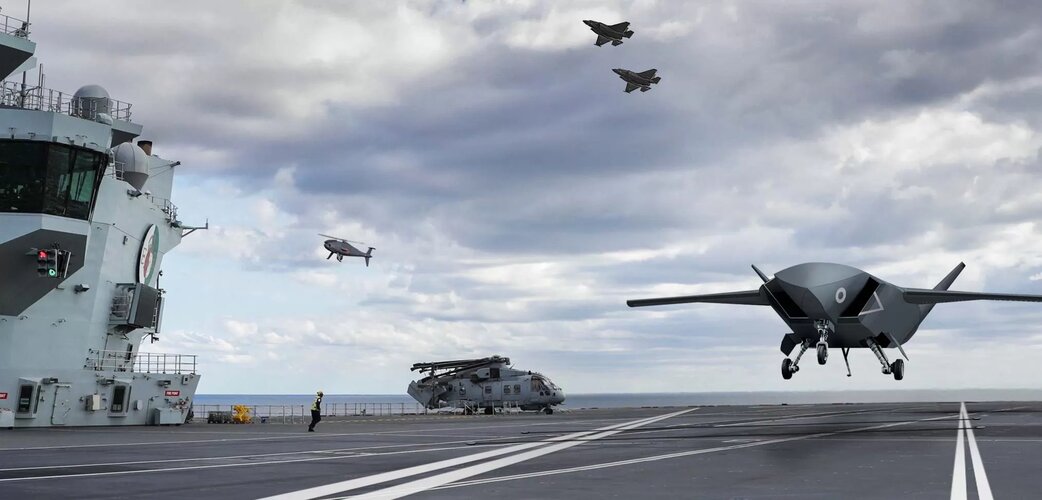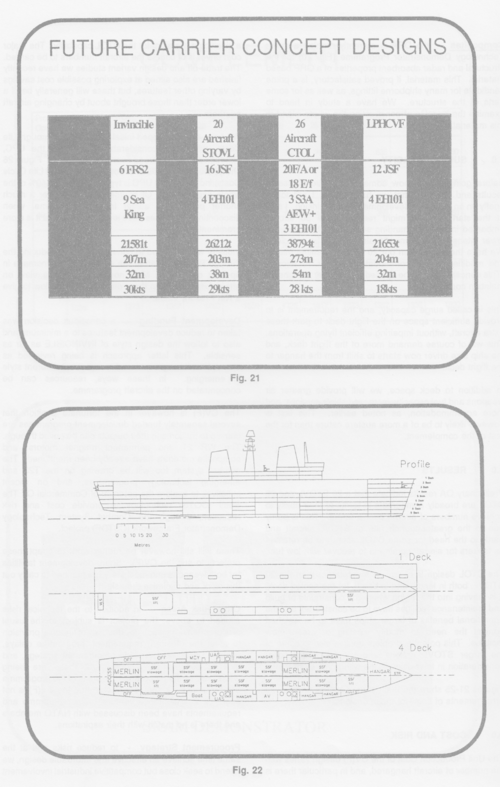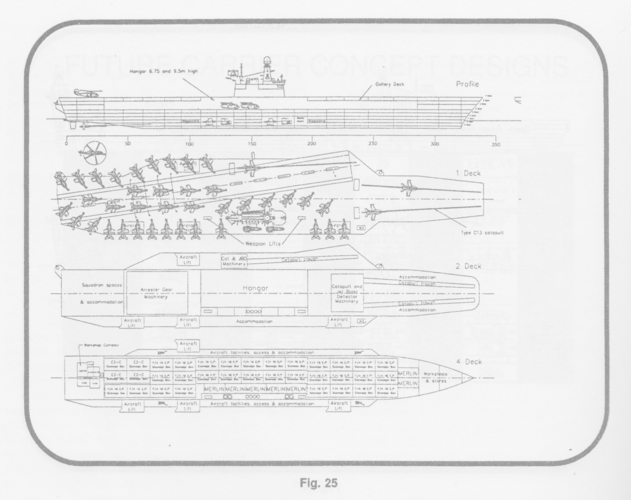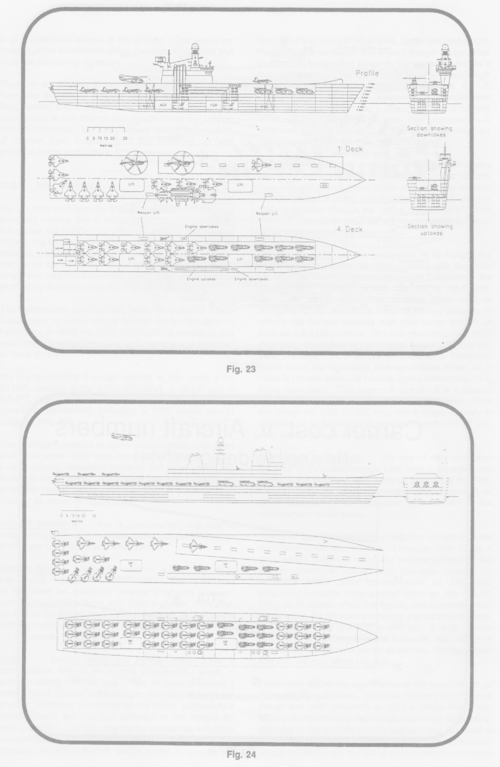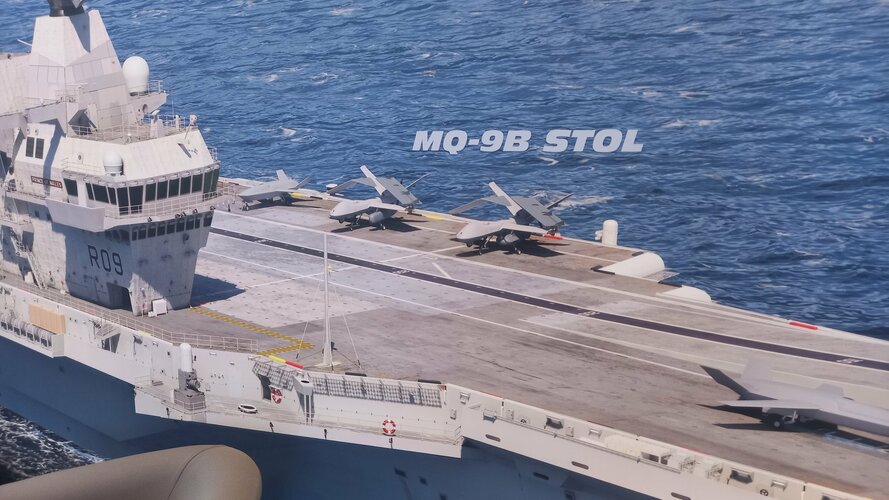You are using an out of date browser. It may not display this or other websites correctly.
You should upgrade or use an alternative browser.
You should upgrade or use an alternative browser.
Queen Elizabeth Class (CVF) development
- Thread starter Triton
- Start date
Attachments
- Joined
- 6 September 2006
- Messages
- 4,829
- Reaction score
- 9,422
Well at least Vixen is still going, it had gone very quiet on that front and wasn't clear if it was still a running programme.
It seems a bit of a mishmash but if the RN is really going to get 2-3 UAV systems in reasonable numbers then it makes sense to make these modifications so that they can be operated.
F-35C and E-2D have sailed down the river a looooong time ago.
It seems a bit of a mishmash but if the RN is really going to get 2-3 UAV systems in reasonable numbers then it makes sense to make these modifications so that they can be operated.
F-35C and E-2D have sailed down the river a looooong time ago.
- Joined
- 25 January 2020
- Messages
- 1,279
- Reaction score
- 1,948
In the long run, one could make the argument that not going with EMALS may have been a saving grace for the QE-class, especially in regards to the development issues and cost with the system in the US. Had the UK gone for that system, it would have likely been co-developed, which would have likely led to political difficulties and would have meant that the UK's carrier program would have been dependent on the US.
It depends on the UAV systems in development. Smaller, and slower, UAS systems could be operated without a catapult, with Mojave being able to takeoff and land in a 300ft space. If the UK does go ahead with the Mojave, or even a modified Protector, they would not be the first to explore this, with the Turkish Navy using the TB3 and the US Marines are looking into using the Reaper off of their LHDs. Relatively few modifications would be needed for these, at least, to my knowledge, with the drones being able to use existing infrastructure for training and maintenance, apart from the carrier landings. For the possible future roles being pursued by the Royal Navy, such as ISTAR, IFR and AEW, larger UAVs will be necessary, which would definitely require cats and traps, unless the UK would decide to attempt going for STOBAR operation with drones, but that is a completely different debate.It seems a bit of a mishmash but if the RN is really going to get 2-3 UAV systems in reasonable numbers then it makes sense to make these modifications so that they can be operated.
Meant to post these sooner:

How 13 Whitehall mandarins crippled Britain’s aircraft carriers
Disastrous chain of events weakened the UK’s most critical defence system – but there is a remedywww.telegraph.co.uk

Whitehall mandarins did not cripple Britain’s aircraft carriers – here’s why we got it right
My first hand account of the engineering success story behind Britain's two new warshipswww.telegraph.co.uk
So, instead of getting two jump jet carriers for £6bn, which meant we would always have at least one carrier available, we would have spent £8bn for one catapult carrier, available about two-thirds of the time.
Issues of range and payload were discussed. But the results were clear. If defence had an extra £2bn to invest in carriers, it would provide more combat power, more of the time, to have two jump jet ships and more aircraft than one deck and a catapult.
As a result of that quite proper decision, properly made, Britain now has two functioning aircraft carriers which are badly needed in the current climate.
Couldn't help thinking - sounds mightily familiar situation... on the other side of the Channel.
Gimme a break... trying to wrap my mind around that Ark Royal thing.
1- We are not talking about a return to "CATOBAR with F-35C & E-2s" as in the 2010-2012 period
2-BUT instead, of a truly HYBRID carrier
3-Something akin to
a) "Keep the VSTOL F-35B with no catapults
b) add medium size EMALS catapults to add a big drone capability, straight out of USN MQ-25 Stingray tanker drone
Am I correct here ? or did I got the entire thing completely wrong ?
In a sense, it is an atempt at bringing a CATOBAR-capability to the Q.E with two major innovations of the last decades
- EMALS
- Fat drones
I'm starting to see a trend, a pattern.
-Chinese drones on their STOBAR carriers
- Chine drones on their big amphibs
- Turkish drones on their own big amphib
- Drones and F-35B on the big USMC amphibs
- RN "Ark Royal" plan to provide a CATOBAR-EMALS-Drone capability to the Q.Es.
Clearly, something is happening. Drones & EMALS are working hand in hand to return CATOBAR capabilities to ships smaller than Ford & Nimitz 100 000 tons. Such as the Q.E 70 000 tons, or large Amphibs in the 25 000 - 45 000 tons range.
1- We are not talking about a return to "CATOBAR with F-35C & E-2s" as in the 2010-2012 period
2-BUT instead, of a truly HYBRID carrier
3-Something akin to
a) "Keep the VSTOL F-35B with no catapults
b) add medium size EMALS catapults to add a big drone capability, straight out of USN MQ-25 Stingray tanker drone
Am I correct here ? or did I got the entire thing completely wrong ?
In a sense, it is an atempt at bringing a CATOBAR-capability to the Q.E with two major innovations of the last decades
- EMALS
- Fat drones
I'm starting to see a trend, a pattern.
-Chinese drones on their STOBAR carriers
- Chine drones on their big amphibs
- Turkish drones on their own big amphib
- Drones and F-35B on the big USMC amphibs
- RN "Ark Royal" plan to provide a CATOBAR-EMALS-Drone capability to the Q.Es.
Clearly, something is happening. Drones & EMALS are working hand in hand to return CATOBAR capabilities to ships smaller than Ford & Nimitz 100 000 tons. Such as the Q.E 70 000 tons, or large Amphibs in the 25 000 - 45 000 tons range.
- Joined
- 15 July 2007
- Messages
- 4,875
- Reaction score
- 4,526
Calling it Ark Royal could also signal the Army is willing to back the RN if the need is to go full CATOBAR for some reason.
From Day1 of revealing Team Tempest, opposition from sectors of the Services and beyond has been profound.
It's very curious to see a Colonel giving a presentation on getting catapults and arrestor gear on a carrier.
From Day1 of revealing Team Tempest, opposition from sectors of the Services and beyond has been profound.
It's very curious to see a Colonel giving a presentation on getting catapults and arrestor gear on a carrier.
Elsewhere it has been noted that he is a Colonel in the Royal Marines, and is one of the RN's most experienced fast jet pilots.Calling it Ark Royal could also signal the Army is willing to back the RN if the need is to go full CATOBAR for some reason.
From Day1 of revealing Team Tempest, opposition from sectors of the Services and beyond has been profound.
It's very curious to see a Colonel giving a presentation on getting catapults and arrestor gear on a carrier.

Phil Kelly (pilot)
- Joined
- 6 September 2006
- Messages
- 4,829
- Reaction score
- 9,422
So I thought I'd pop into the library at work at lunchtime and see about getting around to scanning this properly.The series of CVF configuration studies published in the conference paper, Warship '97 International Symposium: Air Power at Sea, I posted back in 2012 have been lost to time.
I seem to have lost my original scans but fortunately the document still survives in the library so I took some phone camera pics I have re-attached here. I will make some better scans in due course.
Turns out its gone to the pulping machine in the sky along with a whole bunch of other oversize books...
On the bright side the kiddiwinks don't have to strain their eyes looking at more than a dozen book spines per shelf.
Plus the library have helpful stuck in "Can't Find What You are Looking For?" cards between every other book of those still remaining! Well I would have found it had some numpty not culled it!
So yeah, a fuming rant for me but make the most of the phone pics folks cos' you ain't gonna see these again, unless you happen to turn up a copy of the conference paper.
FighterJock
ACCESS: Above Top Secret
- Joined
- 29 October 2007
- Messages
- 5,577
- Reaction score
- 5,896
I think that the QE carriers should have been full CTOL from the start and purchasing the F-35C too and not messing around with the STOVL F-35B model and ski jumps, that would have saved a lot of money and the carriers could have been in service a lot sooner than they were. It just makes me mad thinking about it. 
- Joined
- 16 April 2008
- Messages
- 9,586
- Reaction score
- 14,408
I think that the QE carriers should have been full CTOL from the start and purchasing the F-35C too and not messing around with the STOVL F-35B model and ski jumps, that would have saved a lot of money and the carriers could have been in service a lot sooner than they were. It just makes me mad thinking about it.
Ski jump is well-known technology and did not add significant cost or delay to the QEs. In contrast, EMALS is just entering service with the USN on Ford (IOC was only achieved in late 2021), and would not have been any earlier for the QEs. It also would have added significantly to the cost. The French are looking at a cost of ~$1.3 billion just to acquire 2 EMALS cats and an AAG arresting set from the US for their next carrier. That doesn't even include the additional ship engineering to accommodate the cats.
And, yes, it does have to be EMALS, because there's no steam plant on the ship. Adding a "donkey boiler" just to feed the catapults was discussed, but that's another significant cost and ship impact. And it's not like the steam cats are cheap, anyway. Especially considering it would likely be a production restart, since the USN stopped buying steam cats well before QE started construction.
- Joined
- 5 May 2007
- Messages
- 1,479
- Reaction score
- 2,846
As luck would have it, I've got copies of at least some of the 2012 scans. Will upload tonight when I'm on the right machine.So yeah, a fuming rant for me but make the most of the phone pics folks cos' you ain't gonna see these again, unless you happen to turn up a copy of the conference paper.
I may have an angle on obtaining a copy of the conference proceedings, but that's something that'll have to wait a few weeks before I can investigate it.
FighterJock
ACCESS: Above Top Secret
- Joined
- 29 October 2007
- Messages
- 5,577
- Reaction score
- 5,896
I had forgotten about the US not getting anymore Steam Catapults TomS, and going with EMALS instead. If the Royal Navy want to go down the true CTOL carrier route the only option would be to start designing new CTOL carriers equipped with EMALS and replace the QE carriers. It would be expensive but well worth it in the end.
When it comes to carriers and their aircraft it seems to me that there are two options:-
1. Expensive carrier for CTOL with (slightly) cheaper aircraft OR
2. Cheaper carrier for VSTOL with more expensive and a bit less capable aircraft.
Either way the spend is in the billions! And even more billions to go nuclear. And you can argue until the cows come home about which is the best, as happens on this site and many others every day.
Edit:- and with option 1 comes a much heavier dedicated training requirement AIUI.
1. Expensive carrier for CTOL with (slightly) cheaper aircraft OR
2. Cheaper carrier for VSTOL with more expensive and a bit less capable aircraft.
Either way the spend is in the billions! And even more billions to go nuclear. And you can argue until the cows come home about which is the best, as happens on this site and many others every day.
Edit:- and with option 1 comes a much heavier dedicated training requirement AIUI.
- Joined
- 5 May 2007
- Messages
- 1,479
- Reaction score
- 2,846
Thanks @Yellow Palace. I cleaned up some of the drawings and scaled them to Shipbucket scale (2px = 1m ft).
Fig. 22 looks like either the 20 aircraft STOVL design described in Fig 21 (203m, 26,212 tonnes, 16 JSF + 4 Merlin) or perhaps the LPHCVF?
Fig. 23 looks like the 35,000 ton STOVL design described in the article... seems like a rather good, balanced design? (Surge airwing of up to 30 aircraft, e.g. 20 STOVL + 10 Merlin)
Fig. 22 looks like either the 20 aircraft STOVL design described in Fig 21 (203m, 26,212 tonnes, 16 JSF + 4 Merlin) or perhaps the LPHCVF?
Fig. 23 looks like the 35,000 ton STOVL design described in the article... seems like a rather good, balanced design? (Surge airwing of up to 30 aircraft, e.g. 20 STOVL + 10 Merlin)
Attachments
Last edited:
- Joined
- 16 April 2008
- Messages
- 9,586
- Reaction score
- 14,408
Excellent!
Are those dimensions are overall length or waterline (or pp)?
Gotta be perpendiculars. The LOA for that 26-aircraft CTOL design is almost exactly 300 meters.
- Joined
- 1 February 2011
- Messages
- 2,929
- Reaction score
- 3,589
I'm not so sure about that.Gotta be perpendiculars. The LOA for that 26-aircraft CTOL design is almost exactly 300 meters.
The data given for Invincible: 21.581tons, 207x32m 30knots, not quite match the true values:
196,75 (wl) x 210 (oa) x 35 x 8,8meters, 28knots and 16.860/20.600tons
- Joined
- 5 May 2007
- Messages
- 1,479
- Reaction score
- 2,846
I'd suggest that the figures used in an academic paper submitted by an RCNC officer are likely to be more accurate than those in naval reference books. Accurate to what is a excellent question, however.I'm not so sure about that.
The data given for Invincible: 21.581tons, 207x32m 30knots, not quite match the true values:
196,75 (wl) x 210 (oa) x 35 x 8,8meters, 28knots and 16.860/20.600tons
As a general matter, the length reported is likely to be between perpendiculars unless stated otherwise. That's the figure that's most useful to naval architects, and is intended to allow like-for-like comparisons. Beam is likely to be waterline, for similar reasons. And displacement is mostly a made-up number, especially if someone's quoting it to five significant digits.
The other identifiable arrangements all assume the entire air wing can be struck below, and Fig. 22 has 12 JSF and 4 Merlins. This means it must refer to the LPHCVF option, which I suspect - based on the size and arrangement - 'what if we just order a modified OCEAN to operate JSF'? A deck park, of course, allows for additional surge capacity. How much depends on what proportion of deck park you accept... historically, the RN has preferred a much lower proportion of the air wing on deck than the USN.
Last edited:
- Joined
- 1 February 2011
- Messages
- 2,929
- Reaction score
- 3,589
I disagree. Only tankers have 50m+ wide hulls. A 273x54m is close to 1:5 LW ratio which is very bad hydrodynamically! Carriers have long sleak hull for speed and the 100.000ton 300m+ long Ford have only a 40,8m wide hull on the waterline!
To me these values in the first page seems approximate values by someone who did not have access to the official numbers.
None the less it is interesting that half the designs are just enlarged/ lenghtened Invincibles and the other half had modern angled flight decks.
To me these values in the first page seems approximate values by someone who did not have access to the official numbers.
None the less it is interesting that half the designs are just enlarged/ lenghtened Invincibles and the other half had modern angled flight decks.
Last edited:
- Joined
- 5 May 2007
- Messages
- 1,479
- Reaction score
- 2,846
The lead author on the paper, J. F. P. Eddison, is also the lead author on the paper referenced by @RP1 in this thread. At thet time, they were working for the Ministry of Defence in the Future Projects (Naval) team.To me these values in the first page seems approximate values by someone who did not have access to the official numbers.
Frankly, I think it's extremely unlikely that a naval architect working for the UK Ministry of Defence on the design of their future aircraft carriers would not have the official figures for their existing aircraft carriers.
Scratch that. It's not unlikely. It's damn near impossible.
In the absence of the full paper, we may not be able to confirm how those measurements were defined. But we can be confident that they are accurate for those definitions.
- Joined
- 6 September 2006
- Messages
- 4,829
- Reaction score
- 9,422
Many thanks @Yellow Palace for saving these for posterity (my original scans got lost in a back-up hard drive crash a few years back).
Interesting that only Fig.24 shows one of the canard McD/BAe JAST design studies, all the rest seem to show the X-35. The 26 STOBAR design looks to have a Eurofighter on it!
Fig.25 looks like an updated CVA-01 concept, F/A-18s and E-2s - heady stuff! In fact a few of these seem to have retained the 'Alaskan Highway' layout with outboard weapon lifts.
C-13 seems to be the stand-in catapult design, I guess there would be no other choice at that time.
Plus it must be stressed that these are concept studies before industry got their studies underway. Looking at these concepts it feels like the CVF we ended up wasn't a bad thing at all. Even the smallest STOVL designs here show the extent of the increase in size required over the Invincibles for even quite modest airwing sizes.
Interesting that only Fig.24 shows one of the canard McD/BAe JAST design studies, all the rest seem to show the X-35. The 26 STOBAR design looks to have a Eurofighter on it!
Fig.25 looks like an updated CVA-01 concept, F/A-18s and E-2s - heady stuff! In fact a few of these seem to have retained the 'Alaskan Highway' layout with outboard weapon lifts.
C-13 seems to be the stand-in catapult design, I guess there would be no other choice at that time.
Plus it must be stressed that these are concept studies before industry got their studies underway. Looking at these concepts it feels like the CVF we ended up wasn't a bad thing at all. Even the smallest STOVL designs here show the extent of the increase in size required over the Invincibles for even quite modest airwing sizes.
- Joined
- 5 May 2007
- Messages
- 1,479
- Reaction score
- 2,846
This was also just prior to the 1998 Strategic Defence Review, which made the following statement:Plus it must be stressed that these are concept studies before industry got their studies underway. Looking at these concepts it feels like the CVF we ended up wasn't a bad thing at all. Even the smallest STOVL designs here show the extent of the increase in size required over the Invincibles for even quite modest airwing sizes.
To meet our longer term needs, we plan to replace our current carriers from around 2012 by two larger, more versatile, carriers capable of carrying a more powerful force, including a future carrier borne aircraft to replace the Harrier. These plans willnow be developed in detail in the normal way. [...]
[W]e plan to replace our threesmall carriers with two larger carriers from around 2012. Work will now begin to refine ourrequirement but present thinking suggests that these might be of the order of 30,000-40,000tonnes and capable of deploying up to 50 aircraft, including helicopters.
Given that the 26-aircraft STOVL carrier was coming in at just shy of 40,000 tonnes, it must have been obvious to all involved that the result would unavoidably have been toward the top end of that size range. And not secretly, either, given that this paper was published the year before!
I suspect that the angled deck carriers resembling CVA-01 is largely because, when designing a new large carrier, you'll naturally gravitate towards the last one you designed. The very square-looking STOVL carriers also bear a strong resemblance to the early CGI back on Page 1 of this thread.
FighterJock
ACCESS: Above Top Secret
- Joined
- 29 October 2007
- Messages
- 5,577
- Reaction score
- 5,896
I wonder what the Royal Navy would have been like back in the 1980s had CVA-01 not been cancelled.
- Joined
- 16 April 2008
- Messages
- 9,586
- Reaction score
- 14,408
I wonder what the Royal Navy would have been like back in the 1980s had CVA-01 not been cancelled.
that_person
ACCESS: Secret
- Joined
- 25 May 2021
- Messages
- 334
- Reaction score
- 633
Hate to be that guy, but SB scale is 2 pixels = 1 foot. That would throw all the other measurements offThanks @Yellow Palace. I cleaned up some of the drawings and scaled them to Shipbucket scale (2px = 1m).
Fig. 22 looks like either the 20 aircraft STOVL design described in Fig 21 (203m, 26,212 tonnes, 16 JSF + 4 Merlin) or perhaps the LPHCVF?
Fig. 23 looks like the 35,000 ton STOVL design described in the article... seems like a rather good, balanced design? (Surge airwing of up to 30 aircraft, e.g. 20 STOVL + 10 Merlin)
Oops I meant 2px = 1ft. The drawings should be correctly sized for ShipbucketHate to be that guy, but SB scale is 2 pixels = 1 foot. That would throw all the other measurements off
P.S. I like to use Shipbucket scale to do quick side-by-side comparisons of different designs. For example, here’s the ~35,000t STOVL design in Fig 23 next to Cavour. I like the small island… on the other hand the lifts seem too small and the hangar extends too far forward, so not sure this study was entirely realistic.
Attachments
Last edited:
Seemingly by the fact that those figures have "SSF lift"s instead of just "lift"s or "JSF lift"s as shown on other figures, I do think that those figures are a bit older indeed. Presumably from the early 1990s?Interesting that only Fig.24 shows one of the canard McD/BAe JAST design studies, all the rest seem to show the X-35.
- Joined
- 16 April 2008
- Messages
- 9,586
- Reaction score
- 14,408
Seemingly by the fact that those figures have "SSF lift"s instead of just "lift"s or "JSF lift"s as shown on other figures, I do think that those figures are a bit older indeed. Presumably from the early 1990s?
Yeah, I think the aircraft in slide 24 is the Lockheed CALF, not the McAir/BAE JSF.
Post in thread 'Lockheed ASTOVL, JAST, JSF projects' https://www.secretprojects.co.uk/threads/lockheed-astovl-jast-jsf-projects.238/post-52381
Last edited:
- Joined
- 6 September 2006
- Messages
- 4,829
- Reaction score
- 9,422
Maybe but this BAe concept looks pretty similar: https://www.secretprojects.co.uk/th...-mrf-jast-jsf-studies.2392/page-3#post-115230
But the McD/Northrop/BAe JAST 4 concept looks very close: https://www.secretprojects.co.uk/th...-mrf-jast-jsf-studies.2392/page-4#post-130089
But the McD/Northrop/BAe JAST 4 concept looks very close: https://www.secretprojects.co.uk/th...-mrf-jast-jsf-studies.2392/page-4#post-130089
F.L.
ACCESS: Top Secret

Primeiro pouso a bordo de um drone em um porta-aviões britânico
O drone W Autonomous Systems (WAS) pousou pela primeira vez no convoo do HMS Prince of
F.L.
ACCESS: Top Secret

Drone faz história pousando em porta-aviões da Royal Navy no mar - Poder Naval
Avião sem piloto pousou e decolou de um porta-aviões da Marinha Real pela primeira vez
www.naval.com.br
- Joined
- 6 September 2006
- Messages
- 4,829
- Reaction score
- 9,422
I've moved all the off-topic ranting to the Military section. This thread is for CVF developments/Queen Elizabeth-class upgrades, updates etc. and associated technical stuff.
Clickbait Youtube videos, rose-tinted reminiscences about things 50 years ago, discussions on catapults, laments over Sea Harriers or AEW and arguments about whether your enemy should see the bombs aimed at his head are superfluous for this thread.
Clickbait Youtube videos, rose-tinted reminiscences about things 50 years ago, discussions on catapults, laments over Sea Harriers or AEW and arguments about whether your enemy should see the bombs aimed at his head are superfluous for this thread.
- Joined
- 22 April 2012
- Messages
- 2,257
- Reaction score
- 2,289
Original Thales/BMT CVF Alpha design, this version was developed as both STOVL and CTOL. Note the following features:
From The Design of HMS Queen Elizabeth and HMS Prince of Wales by S.T.D. Knight of the Aircraft Carrier Alliance, additional details (e.g.length) from Jane's articles of the time.
- Capacity for 40 aircraft, with a surge to 50, space in the hangar for 26, able to support 150 sorties a day ("typical profile")
- 4 x MT30 (160 MW in total) gas turbines, podded propulsion
- There appears to be a SAMPSON on the aft island
- 292m long, as opposed to the 280m long of the final design, and 73,000 tonnes
- Complement of 1,593 of which 632 were for the air group
From The Design of HMS Queen Elizabeth and HMS Prince of Wales by S.T.D. Knight of the Aircraft Carrier Alliance, additional details (e.g.length) from Jane's articles of the time.
Attachments
A Tentative Fleet Plan
I really should change my personal text
- Joined
- 9 April 2018
- Messages
- 1,208
- Reaction score
- 2,811
Some earlier concepts from 1997 here:

RN Aircraft Carrier Studies
RN Aircraft Carrier Studies. December 1997. J. F. P. EDDISON, R.C.N.C.
library.imarest.org
Attachments
'Easter egg' ? F-35C tucked between the bridge structures 
- Joined
- 9 October 2009
- Messages
- 21,928
- Reaction score
- 13,552
UK Eyes Carrierborne Mission For Protector UAVs | Aviation Week Network
The UK is investigating the possibility of operating its new fleet of General Atomics Protector UAS from the country’s two aircraft carriers.aviationweek.com
Similar threads
-
Royal Navy Future Surface Combatant (FSC) - until late 2004
- Started by Triton
- Replies: 13
-
Royal Navy Type 45 ("D" Class) Destroyer Daring Class concepts
- Started by Triton
- Replies: 20
-
Non-monohull forms (SWATH, catamarans, tri-marans)
- Started by Triton
- Replies: 17
-
-
Air Defense Ship (ADS)/Indigenous Aircraft Carrier (IAC)/Vikrant-class Carrier
- Started by TinWing
- Replies: 96

